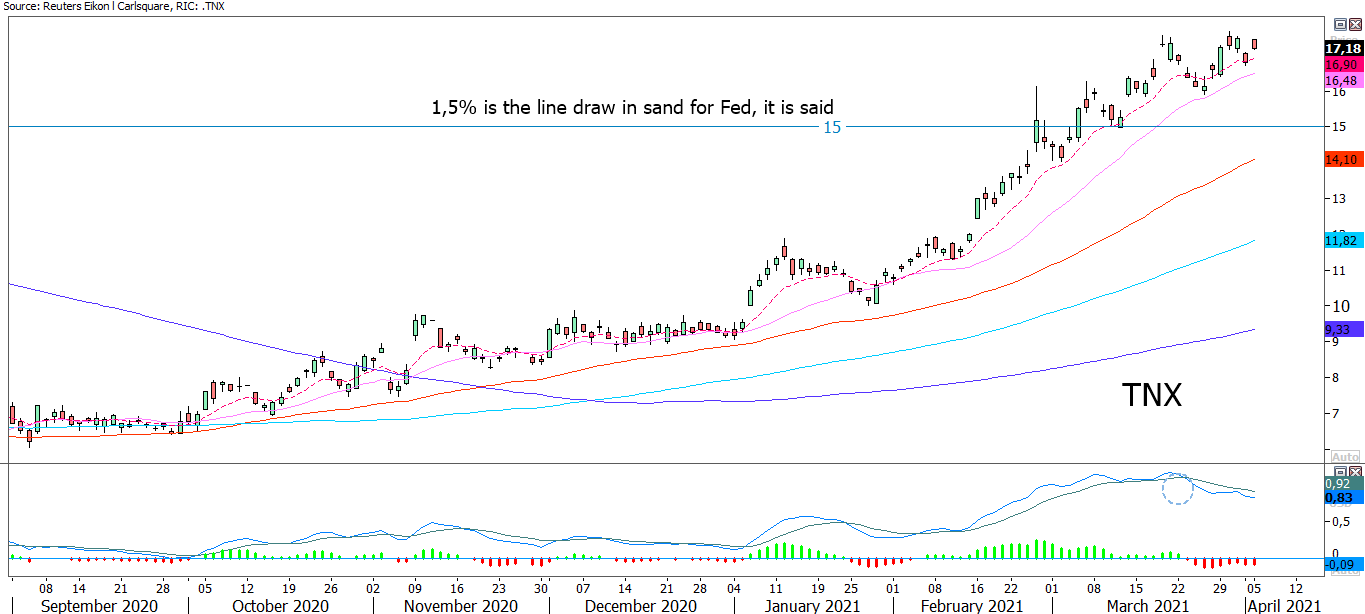Strong start to the reporting season in the United States


The reporting season has started well in the United States. The relatively few companies that have reported so far have generally managed to exceed the market’s earnings expectations. But it is not until next week (April 12-16) that the major US banks will submit their reports and thus decide whether the reporting season will be as good as it started.
The reporting season has started well in the United States. The relatively few companies that have reported so far have generally managed to exceed the market’s earnings expectations. But it is not until next week (April 12-16) that the major US banks will submit their reports and thus decide whether the reporting season will be as good as it started.
One of the larger banks that disappointed the stock market most recently by submitting a Q4 2020 report with some credit provisions was Wells Fargo. But following an initial stock price decline, a strong price recovery began in February. The WFC share has now risen sharply ahead of the bank’s Q1 2021 interim report, which will be presented on April 14.

During the last four weeks (March 2-1 April), 16 of 504 companies included in the S&P500 index have reported their Q1 2021 results. The outcome so far has been very good. Weighted by total profit according to Refinitiv Reuters basic data and Carlsquare´s calculations, the S&P500 companies have on averaged managed to exceed the stock market’s forecasts by 5.5 percent. There have also been an upward revision of these companies’ Q2 2021 profit forecasts by 6.3 percent (this measure also weighted by total profits according to our calculations and with profit data from Refinitiv Reuters).
According to FactSet, the S&P500 companies’ results have changed with the following percentages quarterly since Q1 2017. As can be seen, the last three quarters are positive and Q1 2021 looks to be the best so far. On the other hand, there was a long period with negative figures calculated from Q1 2018 until Q3 2020, of which Q2 2020 with a 37 percent profit decline was worst. Calculated for the full year, the profit loss amounted to 3.3 percent in 2019 and 9.8 percent in 2020 according to FactSet, to so far be plus 5.0 percent for FY 2021.

But now it has turned for the better. On the one hand, analysts seemed to have revised down their earnings forecasts too much in connection with the Covid-19 pandemic. In addition, the general economic development in the United States has turned out better than anticipated. This despite the pandemic and the restrictions as a result. The US GDP growth forecast in 2021 has been revised upwards from 4.0 percent as of 31 December 2020 to 5.7 percent as of 31 March 2021. Furthermore, rising commodity prices and interest rates (net) contribute to a smaller part in the total profit level increase for the S&P500 companies. Finally, the S&P500 companies have started to provide more and more positive forward-looking profit guidance.
The companies that have reported so far and their results are shown in the table below. Nine of the 16 companies that have reported are in one of the two consumer goods sectors (non-cyclical and cyclical), four in technology and three in industry. The United States is ahead of Europe in the recovery cycle, which will be reinforced by the fact that the vaccination is significantly faster in the United States (and the United Kingdom). The trends we see in the US are likely to be seen in Europe about one to two quarters later. The pattern indicates that there will be a rapid recovery for, for example, the sales of clothes and shoes, but also building materials, transports, and restaurants. The proportion of positive earnings surprises for the S&P500 companies is 88 percent, while 81 percent of the companies have exceeded the revenue forecasts.

It is only next week that the major US bank reports could confirm that the Q1 2021 will be as strong as expected. In the table below, we have compiled earnings per share-expectations for several of the larger S&P500 companies with report dates. The column on the far right shows how much the analysts have revised up their earnings forecasts for the next 30 days. Apparently, this is quite a lot for the US banks, probably due to the rising interest rate level on the 10-year US government bond. However, increased investment banking activities in the wake of the strong stock market development should also have contributed to the revised profit forecasts.

US bank stocks have also been strong recently, as have other value stocks driven by rising US interest rates. Correspondingly strong price patterns can be seen for the OMX30 index, which is dominated by value shares in industry and banks.

Rising interest rates have hampered the tech sector, but Nasdaq is now breaking up with a significant price potential towards the previous peak.

The valuation of the New York Stock Exchange then? Yes, the fact that the S&P 500 companies’ profit levels are now being revised up at a faster rate than expected is obviously positive. However, the long trend remains- that the valuation for the S&P500 index has become increasingly higher following a strong share price development. This, in turn, can largely be explained by the economic stimulus from the central banks. This is illustrated in the graph below. Calculated from 2014, the p/e-ratio for the S&P500 index has risen by about 40 percent. The question is whether this value gap needs to be adjusted downwards in the long run. A benevolent interpretation is that the lower interest rate level in longer term justifies a large part of the higher P/E-ratio. The more critical person could argue that the profit trend for the S&P companies is only recovering from a lower level. There is still some way to go to a long-time rising corporate profit curve.

Another important economic indicator affecting the New York Stock Exchange is employment developments in the United States. The latest notes have been clearly positive. But seen over the past two years, the numbers of jobs in the US net has become about 6 million fewer. This equals some 30 percent of the exceptional loss in connection with the Covid-19 pandemic outbreak in March/April 2020.

In summary, it looks good, both for the US economy and the S&P500 companies’ profit development. This is even though the valuations on the stock exchanges have run ahead. We are anxiously awaiting the important US bank Q1 2021 reports next week. They need to be good to justify the share price rises so far.
From a technical point of view the index is currently trading back in the narrow rising trend channel. Also note that the negative trend in MACD has been broken. So far, all dips this year have been opportunities to buy:

In Sweden, the OMXS30 index may be entering into another phase of consolidation around the 2 200-level as MACD is falling. But strong momentum in other markets can be helpful:

The Nordea stock can be found amongst the winners. Rising interest rates are one of the drivers. Note that MACD has started to fall. The Q1 2021 results are to be presented in the end of April. Will the bank share until then follow the interest rate?

Interest rates continue to rise in the US. However, in Europe they have started to consolidate. Nevertheless, the EUR/USD has been rising the last days and seem to be on its way towards MA20 currently hovering around 1,1854:

At the same time, copper has broken up from a neutral-like wedge formation. Is the previous top from February next?

Boliden would benefit from rising copper prices. First the falling trendline in the share price graph needs to be broken:

In Germany, the DAX index is flying. In terms of RSI, the index is overbought. But again, dips have so far this year been good opportunities to buy:

Risks
This information is in the sole responsibility of the guest author and does not necessarily represent the opinion of Bank Vontobel Europe AG or any other company of the Vontobel Group. The further development of the index or a company as well as its share price depends on a large number of company-, group- and sector-specific as well as economic factors. When forming his investment decision, each investor must take into account the risk of price losses. Please note that investing in these products will not generate ongoing income.
The products are not capital protected, in the worst case a total loss of the invested capital is possible. In the event of insolvency of the issuer and the guarantor, the investor bears the risk of a total loss of his investment. In any case, investors should note that past performance and / or analysts' opinions are no adequate indicator of future performance. The performance of the underlyings depends on a variety of economic, entrepreneurial and political factors that should be taken into account in the formation of a market expectation.